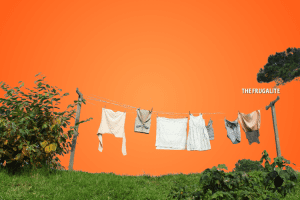(Psst: The FTC wants me to remind you that this website contains affiliate links. That means if you make a purchase from a link you click on, I might receive a small commission. This does not increase the price you’ll pay for that item nor does it decrease the awesomeness of the item. ~ Daisy)
By the author of the online course Growing Self-Sufficiency: The Whole Picture
In this article, I am excited to share the many creative ways I get around “I can’t afford it” so that I can have something anyhow, even if it is made up of somewhat improvised parts. Some might even say I “MacGyver” my way through life, which I would consider a compliment.
The Merriam-Webster Dictionary defines the verb MacGyver as the following: “to make, form, or repair (something) with what is conveniently on hand.” Those of us of a certain age will likely recall the adventures of the character on which this verb is based – secret agent Angus MacGyver.
While I can’t say that I was ever a dedicated fan of the series (having never owned a television in my entire life!), pop culture references have had a way of percolating down to me, so even I know the meaning of this word.
My Fancy “Standing Desk”
While I get a lot of physical activity milking the cows and working on my Half-Acre Homestead, I am a writer, too. These days, the dangers of sitting in front of a computer are becoming more recognized. It was actually a professor at the Mayo Clinic who coined the phrase “sitting is the new smoking.” Research is showing that exercising to try and counteract the negative health effect of sitting hours every day is not enough: you simply need to SIT LESS!
When the one chair I had been using to sit and write broke, I decided it was a sign to reduce my sitting. Did I get online and order myself a new standing desk for $200 – $400? Heck no! I took a look around my eco-cabin for simple MacGyver solutions. Sitting in the main room, I have what looks like a slender wooden desk. It was actually going to be my bathroom vanity until plans changed. I checked the height. It was a little too low.
Hmmmm what to do? Aha!
I simply took a couple of pieces of scrap wood, put them on top, put my laptop on the wood scraps, and voila! My one-of-a-kind improvised standing desk was born. Is it state of the art, with an electric mechanism to raise and lower it? No, but it is off-grid capable! Is it particularly aesthetically pleasing? Maybe not for a high-paid office worker, but it is great for me. What did it cost me? Nada. Now, I am able to change up my routine, check emails and do a bit of writing standing up. If I feel my legs are getting tired, I can always sit down. (We talked more about DIY home office hacks in this article.)
My “Dance Studio”
Living in an 18×24-foot eco-cabin means that space is at a premium. Overall, I don’t mind this, as my goal is to actually show how great life can be while consciously choosing to live with less. This is good both for my pocketbook and for our wonderful planet, Mother Earth. Even so, one might imagine that installing a dance studio in my one-room cabin might be a bit of a stretch!
Well, when I decided at age 53 that I wanted to pick up my childhood passion for ballet, this challenge was nothing a little creativity couldn’t solve. The first issue was the floor. Much of the interior of the eco-cabin is only roughly finished, including the bare concrete floor. It because almost immediately apparent something was going to need to be done, as the bare concrete was wearing holes in my socks and even my ballet shoes due to its rough finish. Oh dear!
My first potential solution was to bring in a light woven outdoor mat, but the weave was catching my ballet shoes in one direction. Hmmmm…..
The solution that finally worked was to buy a square of linoleum from a discount store around 6-foot square. This ended up costing around $40. It is good quality, lays absolutely flat without taping, and is smooth enough to work very well with my ballet shoes. Hurray!
However, there were a few other items required for a good dance studio. First, I needed something to use as a barre. This is the handhold that is grasped lightly for each side for a great deal of strength and flexibility training in ballet. A quick search online located prices for the stand-alone version of these between around $100 to $1,000. Solid wood wall-mounted units were around $250, but there is no wall to mount it on, as most of the eco-cabin wall space is taken up by windows for the passive solar design! It turns out that I had a folding chair with a back that was approximately the right height. When I need to work the other side of my body, I simply move the chair over there rather than turning around.
Finally, most dance studios have mirrors on at least one wall. I solved this by leaning my inexpensive wall mirror up against my standing desk (ha ha, yes, see above!) While perhaps it isn’t quite as wide as I might like, it still allows me to check the correctness of my form and posture while I do the barre exercises.
My Solid Oak “Fridge Stand” and Pot Cupboard
All of the cupboards in my eco-cabin came from Habitat for Humanity. They are solid golden oak. While it is trendy to paint over these now, I just love the bare wood. I needed somewhere to put all of my pots, as my propane range has a grill on the bottom level. To make one, I simply turned a large-size extra cupboard on its side. Voila! All of my pots fit in there. As an added bonus, I put my extra fridge on top of it, and I don’t have to bend down to get my kefir.
My Custom “Corner Shelving Unit”
When I realized that the solid red oak corner units that I had bought from my cousin were not a good fit for the eco-cabin, I negotiated a barter trade for them that I was really happy with. However, while their departure from the eco-cabin improved my view of the surrounding forest, it left me without a place to put my books. So, I invented a custom shelving unit that would fit in the corner and not obstruct my view. I made this out of a wall-mounted microwave stand with solid golden oak cupboard doors that I found by the roadside with a “FREE” sign on it.
With my free microwave stand on the floor, I simply stacked a few solid wood crates that I kept from my tiny house days. Three of these were enough to hold my modest book collection, and I was able to put my refurbished snow shoes on top of the stack. Voila! MacGyver would be proud. A custom corner shelving unit that lets the warming heat of the sun in and allows me to fully enjoy the beauty of nature that surrounds me – and it didn’t cost me a cent!
MacGyver and Thrive-er!
When buying new isn’t an option, you still have lots of options available. Could you see yourself trying any of the creative tips offered here? Do you have one of your own MacGyver solutions you can share with us? Please tell us in the comments below.
About Colette
Colette is passionate about sharing her knowledge of thrifty living and self-sufficiency. She has developed her skills in self-reliance living in the suburbs, the city, and more recently, on her own Half-Acre Homestead. Colette lived five years completely off-grid and without running water in an eight by 24 foot tiny home while designing and building her own 18 by 24-foot eco-cabin. Her website, Half Acre Homestead is attracting followers from around the world who want to become more self-sufficient. Colette invites you to stop by the Homestead and check out all of the great resources including the practical How To Guides, A Tiny Home Resource Center and her organic gardening stories on her blog. She shares her wholistic model (body/mind/spirit) for achieving self-sufficiency in her Free Course, “Growing Self-Sufficiency: The Whole Picture.” Stop by the Homestead today to register free of charge!












14 thoughts on “Can’t Afford It? How to MacGyver It Up Anyhow!”
I used Concrete Blocks and strips of Plywood to make shelving.
When my Cold Pak for my Dinner Bucket went bad I used a clean Peanut Butter Jar instead of running to Wallyworld for a new One.
When the Arthritis in your knees gets bad you will have to go back to a sit down desk. Don’t buy one. They are free on the Craigslist “free” catagory.
Hi Mustang, Thank you for the great tips! Regarding my knees – I added a small anti-fatigue mat to the set up yesterday, which is helping. Wishing you a wonderful Frugalite year in 2023!
When my late neighbor remodeled his house he put multiple sliding glass doors in the alley for trash pickup. When I saw them I asked if I could have them. That’s all it took to archive the critical piece to what would become a solar water distiller that looks like a large pool table with a slightly slanted glass top. The plans and how-to information is in a book by Sharon Buydens on Amazon.
Then I used this video to source and build a Copenhagen style solar panel cooker from dirt cheap parts listed below in the video’s description:
In this 5:56 minute video, from RimstarOrg on Jun 21, 2012:
https://www.youtube.com/watch?v=Ew3RbeuntMg
Step-by-step instructions for how to make a Copenhagen solar cooker. This is a neat solar cooker where the cooking pot stays flat on the ground and the flexible reflectors (or panels) are adjusted around it. I make it using poster board, cardboard, aluminum foil and a shoelace. At the end I show it solar cooking a hard boiled egg.
Plus more detail in the Description.
Plus several related YT video links.
Plus 43 comments.
The only change in parts that I made was to replace the shoelace pieces with quarter inch wide strips of velcro for easier and quicker assembly or disassembly.
—Lewis
Hi Lewis, My goodness! Is there anything that you don’t know and haven’t done. So COOL! Thanks for sharing the link and how you used what looked like a door and turned it into a self-sufficiency treasure. MUCH APPRECIATED! Wishing you a wonderful Frugalite year!
Colette, I always enjoy your articles and I especially liked this one. I have always said that I might be related to MacGyver. I love doing stuff like this. It is so satisfying to give meaning and purpose to something that no longer seems to have one.
Also: I have a question for you. My husband and I are finally getting to move. We will have a half-acre and NO HOA. Hoping to have a few chickens, maybe quail, some bees and lots of fruits and veggies. We won’t be off grid, but we are still going to call it our “homestead” because our goal is to become as self-sufficient as possible. We are looking for a name. For obvious reasons, we won’t name it Half Acre Homestead. But we really want to name it something with the word homestead in it. Any ideas? Thanks. Trish
Hi Trish, Thank you so much for your kind words. What a pleasure to read your comment and hear your exciting news. Free of the HOA! I know that many other Frugalites are happy for you, too. I will do some brainstorming regarding homestead names. If you haven’t been to my website yet, I recommend it, as you could email me and we could continue the conversation. A name that captures something special about your homestead, such as the location (is it near a lake? a historic site? a big hill?) or something special about you and your husband (are you Irish, for example? then, you could give it a Gaelic name) or a particular plant or animal you like.
Another idea would be to walk the homestead and see if something stands out to you….are there lots of pine trees? one particularly striking oak tree? or something else may come to mind. If you like the name of your locality or township or the nearby village, that is also a possibility. A name that would capture your faith, if you are religious, could be very powerful. You could also do some thinking about images related to self-sufficiency. These could be qualities like strength and perseverance, or perhaps the diversity of your crops and critters. One of my friends made her new beginning on a farm and she called it “New Leaf” Farm. That is just one example. I hope that helps start the wheels rolling!
As you can tell, I love brainstorming things like this, being a poet and a writer! Please do feel free to email me to continue the conversation. Now, I am also quite excited to hear what you come up with! Looking forward to hearing from you Trisha. Congratulations to your and your husband, from one MacGyver cousin to another!
Hello Colette
I pulled up your website Half Acre Homestead but I can’t figure out how to email you. I’m afraid I’m not exactly a technology guru ?. It may be that I overlooked something that was right before my eyes. Could you tell me how to find the place to email you? Thank you so much. Happy Homesteading, Trish
Hi Trish, Would love to have you email me! There is a contact page where my email address is located, but I can also give it to you here: welcome@halfacrehomestead.ca . I’m very much looking forward to hearing from you!!!
Back in the 80s, we went through a long period of unemployment/under-employment and were really broke most of the time. We were very blessed to have an old VW bug. There is no heater on the old bugs, just a lever that opens near the floorboard that allows warm engine air into the cab. Our lever broke. My husband discovered that an empty (but clean) tuna can could wedge in to allow the vent to open. The problem was that it was either wide open or closed plus he had lie down on the ground to put the can in place. But he did it.
Also, our battery went dead and we didn’t have money for a new one, so we always parked on an incline, let it roll downhill in neutral, then popped the clutch to start it. That never failed to work,.
Then the starter failed and my husband installed a push button starter on the dash until we could afford the real one.
We did a lot of stuff like that. In 1974 we’d bought a brand new sofa in 1974 that was a big mistake and it wore out way before its time. ‘After we trashed it, we looked and looked at new ones, couldn’t afford/agree on. One day I lamented that I was never going to have another one, when my husband said that he’d build me one. I scoffed and he went out to our shed and brought in ever scrap piece of wood we had and built a base. Th e Army/Navy store had the foam for a good price and I upholstered it. It wasn’t awful, but it was unique. To tell you the truth, I wish we still had it.
Hi Carla, Those are wonderful stories you have shared. Your tuna can story reminded me of the hole in the floor we had in our old “woody” station wagon. That hole didn’t warm the car, unfortunately! I found your story of the sofa quite touching. I can understand why you might still want to have that. I thought it was a beautiful memory of how you made it through together, with lots of ingenuity! Thank you so much for sharing your precious memories. I’m sure they will warm the hearts of many Frugalites on this cold winter day! Wishing you a cozy rest of your Frugalite February and a great 2023!
Thanks for the kind words, Colette. When you mentioned the hole in the floorboard, I remembered the hole in our back floorboard with a small piece of plywood laid over it. I appreciate your articles and this one was particularly fun.
Hi Carla, Ah, you had one, too! Thanks so much for sharing. Wishing you a great year with lots of thrift and frugality to celebrate!
I love stuff like this. It’s not ideal but I have stacked a bunch of plastic milk crates to make a book case – it’s serving well enough for now! My desk was also found by the side of the road with a “Free” sign – it’s made of farticle board but is still a nice big and sturdy roll top desk. It’ll do till we build a new one!
Hi Redbranch, Our home offices sound quite similar. I agree: if it’s serving well enough for now, that is all I need! Wishing you a great 2023. Thanks so much!